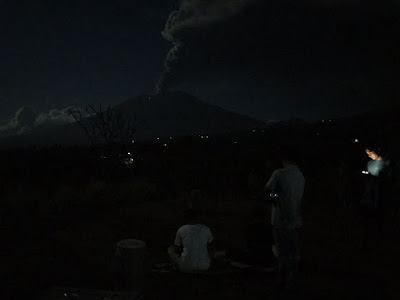Nadia Putri - Ross School of Business
On Thursday, June 28th 2018, I was sitting at East Bali Immersion (EBC's ecocamp), almost couldn't believe what I was seeing. EBI is located NW of Gunung Agung, and I could see small sparks of lava accompanied with tall smoke coming out of the crater. It was really beautiful, but a bit scary at the same time for someone who has never seen anything like it before. We were listening to radio station that keeps everyone updated on which areas have been evacuated.
On Thursday, June 28th 2018, I was sitting at East Bali Immersion (EBC's ecocamp), almost couldn't believe what I was seeing. EBI is located NW of Gunung Agung, and I could see small sparks of lava accompanied with tall smoke coming out of the crater. It was really beautiful, but a bit scary at the same time for someone who has never seen anything like it before. We were listening to radio station that keeps everyone updated on which areas have been evacuated.
 |
| EBI team watches over Gunung Agung on Thurs, June 28 night |
History of Gunung Agung
Gunung Agung (gunung = mount, agung = majestic) is the highest volcano in Bali, towering 3,031 meters (9,944 ft) above sea level. Balinese, whose religions are mainly Hindu, consider and respect mountains as the dwelling of the Gods - with Agung holding the highest degree of sacredness. Pura Besakih (pura = temple), the most important, largest, and holiest Hindu temple in Bali, is located on the slopes of Gunung Agung.
Prior to current activity, the last eruption of Agung started on February 18, 1963 and ended on January 27, 1964. During this period, there were 1,148 casualties and 296 injured victims (PVBMG Indonesia). This eruption was one of the largest in the 20th century, generated heavy ashfall along with lahars that caused extensive damage. Below-average temperature was observed years after the eruption happened. Ash spewed by volcano can cause much struggles to farmers, burying agricultural areas and damaging crops. However, they also increase soil fertility in the long-term.
 |
| Map of areas located in danger zone and EBI + EBC locations. (Source: PVMBG Indonesia) |
Gunung Agung started becoming active again in August 2017. In September, The Indonesian National Disaster Management Authority declared a 12-km evacuation zone around the volcano. Gradually, the activity decreased over time, leading to lowering of alert level to 3 out of 4.
But, late November 2017, Gunung Agung erupted five times. The Indonesian National Disaster Management Authority raised alert level to the highest once again, ordering citizens located in 10-km radius of the volcano (~100,000 people) to evacuate. Since then, Gunung Agung has been erupting with a varying degree of impact.
East Bali Cashews and disaster readiness
EBC factory and EBI are located approximately 14 km NW of Gunung Agung. This means EBC area is still located outside the evacuation zone. But, this does not mean that the management was able to rest easy. In 2017 episode, earthquake can be felt throughout the factory every few minutes. At first, everyone was anxious, scared, and panicked. So, EBC implemented some programs to prepare their employees for any disaster that might come and make sure everyone feels safe at work.
- Tore down one of the factory walls and created larger emergency exit for employees to get out in case of any incidence.
- Trained employees to evacuate in a calm manner, determined gathering area for people to evacuate, and assigned team leaders to call absence when this happens.
- Aaron, EBC's founder, presented volcano simulation to the employees to show what happens when a volcano erupts and how the areas around it will be impacted.
- Management from Denpasar and Jakarta rotated to stay in Karangasem throughout the whole episode, staying together with the employees and keeping everyone calm
These programs and general readiness attitude from management prepared the employees really well. During my stay there, minor eruptions and earthquake happened. But, the employees did not show any panic sign while still keeping in mind what procedures they need to do if anything happens.
 |
| Mount Agung, on my way from Karangasem to Denpasar on Friday, June 29 |
Going back to my experience, I was supposed to fly out to Jakarta on Friday June 29th, the day after I watched Gunung Agung erupted from EBI. When I woke up Friday morning, I found out the airport was closed following the eruption to ensure flight safety. Volcanic ash is dangerous for planes as it makes airport runways slippery and can get into plane engines. Typically, whenever my flight plans are disrupted (believe me, this happens a lot. People know I'm quite unfortunate in terms of flying..), it would ruin my mood for the whole day. I'm tired of all the hassle in lining up at the customer service booth, rescheduling my flights, staying longer (even overnight) at airports, etc.
But, that day was different. I was reminded of my experience the night before.
I remembered watching Gunung Agung with EBI staffs. They've seen it before, yet, they still admired how grand the lava, smoke, and Gunung Agung looked that night. They appreciated the beauty despite the uncertainty of what might come. So I told myself, that it was fine to have my flight plan disrupted - just like thousands others who were trying to fly out of Bali, that in the end everything will be OK, and that I just saw the most amazing evidence how powerful and beautiful our nature is.

No comments:
Post a Comment